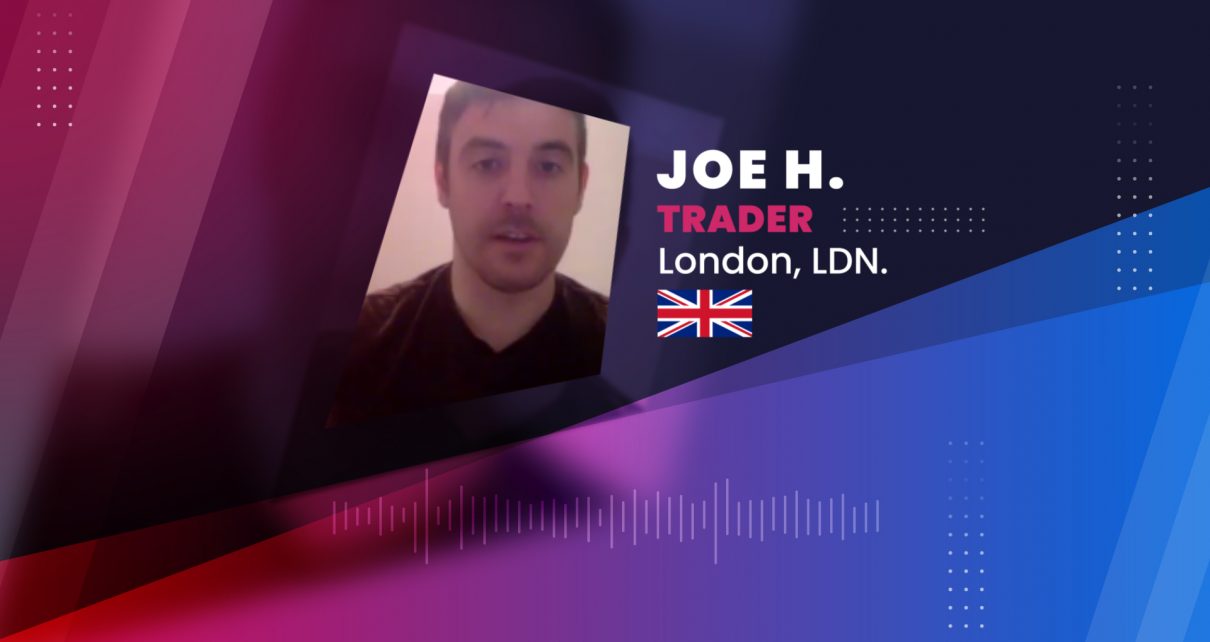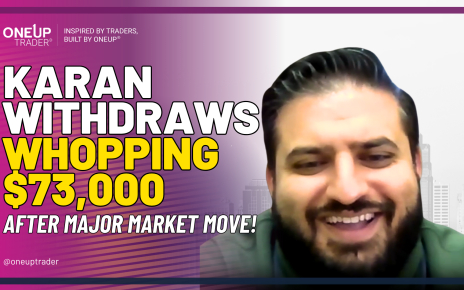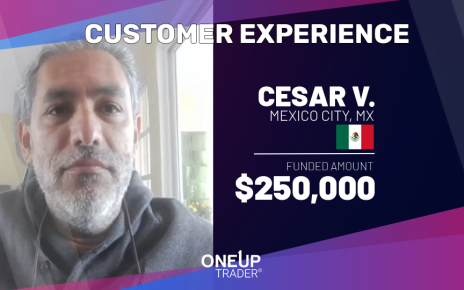Joe H. from London shares how he began his journey as a futures trader. He shares his trading experience with OneUp and explains how OneUp offers traders better options for success compared to related companies out there. He equally shared his tricks for success and offers some useful advice to traders. You can follow this link to listen to the video interview.
How he found out about OneUp Trader
He initially started trading spot FX, which is highly advertised in the UK. However, his spot FX trading was much more passive. He was trading sparingly for a week, a couple of weeks, or maybe for a month. However, he thought that he could move over to futures as well and trade some different markets. But with the leverage futures offers he thought it wasn’t a sensible approach. Then he saw an ad for a different company that offers the same thing as OneUp Trader and he thought it was a good idea. He did a bit of research for a company that offers some funding, and as a result, he found OneUp Trader.
What he didn’t like about other companies
With OneUp Trader, the rules are the same both during the evaluation period and when you get funding, but with other companies, the rules change after the evaluation. They become very restrictive and start to introduce a lot of micromanagement from their end to the detriment of the trader.
His experience before he tried OneUp Trader
He had no previous experience with futures trading or funded trading before OneUp. He was just dipping his toes into futures and was taking his time to learn about futures trading.
Since he had no previous futures trading experience, he knew there was no way he could ever get funded, but he needed to put some amount of money into the evaluation to give himself some time to learn because he thought that it was pretty easier and a lot cheaper than losing the equivalent in real dollars with a live account.
His trading style
He is a discretionary trader. Initially, he started purely with high volume scalping. He still does that at more active times in the market, but as he is evolving, he is turning more into an intra-day position trader from a structured level.
For his trading plans, he starts the day looking at the overnight news, what is happening, looking at overnight charts and then he finds areas he thinks showed key support and resistance levels and, then build a trading plan around that. When he starts to execute trades, he tries to move away from just pure high volume scalping strategy into a more structured trading pattern because he thinks it offers a better long-term chance for success.
The model he is currently following for his trades is the ideas of futures trading 71. He just learned his approach to the market and tries to resonate with them because he was previously his member. He thinks what he says makes a lot of sense, so he uses it to build his trading plan. At specific times, he still does scalping for the opportunities it presents in the market, but what he is doing now is building a scalping around the context of market structure, as opposed to just almost not doing any work and coming in and just trading blindly.
At specific times, he does a lot of scalping. He plans his trading within the structured area and he stays away from trading if there was no trade set up within these structured areas. With the strategy, he knows that he can’t execute unless it’s within the structured areas. So, if he gets stopped out, for example, then he has to wait for his next set up. He found that the strategy helps him to maintain trade discipline. It also helped him to make a significant improvement in his overall performance.
Advice to traders in terms of scalping
He advised traders who want to engage in scalping to allocate a short period they’ll need to be in the market every day. The best time allocation could be an hour or an hour-and-a-half.
He advised traders to be relaxed before they go into the market.
Joe also advised that the moment you start to make a psychological error, you should just go “flat” all your positions, step aside, walk out of your office for a little bit, calm down and then come back.
One problem he finds with scalping is that sometimes it can get very emotional up to the point that he almost starts negating his trading plan at the end of the day. When that happens, he misses out on the big move. So, he advises traders who have a rigid mindset and are comfortable with taking losses, to quickly go into scalping as it would make a fantastic trading option for them. However, those who are not that comfortable with taking the stop loss, should probably pull back on the scalping technique and become more structured.
Signup process
The signup process according to him is a piece of cake. It took about half an hour, to sign up for the evaluation. He mentioned that he got an immediate email from OneUp to say that his payments came through and that he’ll be receiving his details shortly. Then, at about 20 minutes, he got another email from OneUp with all his details. He plugged them into his execution platform and then he was ready to go. Overall, he says that the process was really straightforward and very easy.
About the dashboard
He says that the dashboard is much cleaner and much simpler than others out there. And for things like the consistency rule, he says, if you’re not on top of these rules, you might miss that one, but he thinks OneUp has made the rule blindly obvious. Everything is just laid out for traders so they don’t have to worry about how to hit their targets. They know what to expect right upfront. He also thinks the risk breakdown of trades offered by OneUp is brilliant. Click here to listen to him.
About OneUp rules and suggestions
He likes OneUp’s rules and that was one of the main reasons he came to OneUp. Whereas OneUp doesn’t kick traders out of the evaluation when they have a bad day, he says a lot of OneUp’s competitors kick traders out for the same reason and terminates the evaluation. He likes that and thinks this unique feature offered by OneUp is under-appreciated by a lot of people. It is not that he wants to be doing that, but he thinks it’s a nice sort of support for someone who is having a bad day and looks like OneUp is telling the trader, we know you got what it takes and we’re going to give you a second chance.
His suggestion
A suggestion he raised since he does quite a lot of scalping is the way the trailing drawdown is traded on OneUp, which he thinks makes it a little bit harder for structured intraday position trading, where you might have P and L swings and with the loss limit accounting for unrealized profits as well. He wishes that OneUp Trader will look into that in the future. He also suggests reducing trader’s risk on live accounts like loss limit coming up to the actual account balance. That makes perfect sense, he thinks. And then maybe if the trader gets the account up to that, they could look at daily loss limit from closed positions or something, just to give intraday structured traders a little bit more freedom with slightly larger P and L swings.
His experience with the OneUp Trader support team
He has spoken to the OneUp Trader’s support team through the process of getting funded, sending the relevant paperwork through and he testifies that the team has been really helpful. However, as far as technical support is concerned, he hasn’t used it as everything has been straightforward. He paid for the evaluation and got the information he needed straight away and got logged into the execution platform. Everything was copying over to the dashboard on the website. And then as soon as he emailed OneUp about completing the evaluation, he got a response within 20 minutes and that was in a London morning time when US citizens were still tucked up in bed. He was very impressed with that.
How the process from evaluation to the funded account went for him
The first time he went through the evaluation, it was a little bit quicker, but that happened during the pre-lockdown when he assumed everybody was in the office. So, things just naturally got done a bit quicker. Whereas during lockdown when he made a new application, obviously with everyone working remotely, he experienced a little delay. So, he thinks it’s not just in this specific business but in all businesses, things were a little bit slow at that time. Overall, this time it took him a bit more time. So, in his experience, it takes a couple of working business days to complete.
What he likes and dislikes about OneUp
His overall experience was positive and what he dislikes is not a lot because he has mentioned his concerns about the trailing drawdown earlier. However, regarding that, he says that One Up Trader suggests that once he gets a bit of profit, he can discuss it with his funding partners to increase that drawdown which will give him a little bit of extra room. That is only the slight concern he has, but he had mentioned it before.
Regarding the things he likes about OneUp, he mentioned that he gets a reply very quickly whenever he sends an email.
He has not experienced technical issues with OneUp. Everything, including account logins and stuff, come very quickly.
He also loves that the fact that the rules in the funded account are the same as the evaluation rules. He stressed that OneUp Trader does not kick their traders out of the evaluation if they have a bad day and hit their maximum drawdown. He mentioned that he doesn’t think people are aware of that and thinks they should be because none of OneUp’s competitors offers similar services.
Final advice
He got through the evaluation fast, got funded, and then blew the accounts because he did not work with a trading strategy. He made a few bad decisions that just happened to pay him off during the evaluation process but not when trading with a funded account. It was only a matter of time before things went wrong. And obviously, it went wrong in the funded account. So, he advises new people that think about doing it to ensure that they have done all the work behind whatever strategy they want to use. You can listen to his interview here.
“You must ensure that you have a statistical edge in the market and execute a strategy with a demo account before you start to look at allocations”, he says.
He mentioned that he is just a retail trader trying to see what he can make out of futures trading. He’s not a professional, but trading is his sole source of income. He has been through all the mistakes that the majority of traders are going through. So, his greatest advice to traders is to scale down their size. For him, with the 50K account, he targets a $3,000 profit. If you just trade properly using a small size, he says, it is amazing how quickly the results will show themselves. And, because you’re not blowing your account all the time, it means that you’ll get funded much quicker. You can listen to his video interview here!





